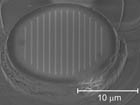April 15, 2011 — Electron microscopes use focused electron beams to make extremely small objects visible. By combining the microscope with a gas-injection system, material samples can be manipulated and nanometer-wide surface structures can be written. Empa researchers, together with scientists from EPFL, used this method to improve lasers.
The vertical cavity surface emitting laser (VCSEL), a semiconductor laser often used in data transmission for short-distance links like Gigabit Ethernet, exhibits one weakness: Because of the cylindrical structure in which the lasers are built up on the wafer, the polarization of the emitted light can sometimes change during operation. Stable polarization is necessary to reduce transmission errors and to use VCSELs in future silicon photonics.
 |
|
Image: The result is a nanostructure — for example, a polarization grating on a VCSEL (vertical cavity surface emitting laser). These are semiconductor lasers frequently used in optical data transmission. |
"We’ve written flat grating structures on the VCSELs with an electron beam," says Ivo Utke, Empa researcher, in describing their solution, "and the gratings were effective in stabilizing the polarization."
 |
|
Image. The principle of the local deposition process, which is induced with a focused electron beam (FEBIP), is that molecules from a gas-injection system are deposited on the sample surface in a reversible manner. The focused electron beam dissociates adsorbed gas molecules. The resulting non-volatile compounds remain permanently on the sample. |
Minimally invasive, direct FEBIP is suitable for prototyping nanocomponents to solve specific questions and problems in applied nanoelectronics, nanophotonics, and nanobiology. Suitable gas molecules are injected close to a sample which is already in the microscope’s vacuum chamber. These adsorb on the sample in a reversible manner.
The focused electron beam induces chemical reactions of the adsorbed gas molecules, but only at the spot where the beam strikes the surface. The resulting non-volatile molecular fragments then remain permanently on the sample while the volatile fragments are removed by the vacuum system. "With the help of a precisely positioned electron beam, it’s possible to remove or apply surface structures with nanometer precision and in virtually any desired three-dimensional shapes, explains Utke. "FEBIP could soon become a true nanofabrication platform for rapid prototyping of nanostructures in a minimally invasive way, without necessitating the large investment of a clean room."
The team was led by Utke, together with scientists from the Laboratory of Physics of Nanostructures at EPFL. The study has recently been published in the scientific journal Nanoscale as an advanced online publication. Access the article here.
Learn more at www.empa.ch
Follow Small Times on Twitter.com by clicking www.twitter.com/smalltimes. Or join our Facebook group

